Artificial intelligence has blessed the enterprises with a very useful innovation – the chatbot. Today, almost every other consumer firm is investing in this niche to streamline its customer support operations.
However, despite being around for years, numerous firms haven’t yet succeeded in an efficient deployment of this technology. Perhaps, most organizations stumble while deploying a chatbot owing to their lack of knowledge about the working and development of chatbots. Moreover, sometimes, they are also unclear about how a chatbot would support their day-to-day activities.
Therefore, with this article, we explain what chatbots are and how to build a chatbot that genuinely boosts your business.
What Is A Chatbot
A chatbot is a dedicated software developed to communicate with humans in a natural way. Most chatbots integrate with different messaging applications to develop a link with the end-users. Though, some chatbots also function as standalone apps.

Most businesses build a chatbot for managing customers and online visitors. Though, the organizations may either use them as the sole resource for customer support or, assist the human staff.
To manage the conversations, chatbots follow a question-answer pattern. Whereas, the recognition of the question and the delivery of an appropriate answer is powered by artificial intelligence and machine learning.
How Do Chatbots Work?
The core functioning of chatbots entirely depends on artificial intelligence and machine learning. Then, depending upon the requirements, an organization can create a chatbot empowered with Natural Language Processing (NLP) as well.
In general, a chatbot works by comparing the incoming users’ queries with specified preset instructions to recognize the request. For this, it processes the queries through complex algorithms and then responds accordingly.
Based on how the chatbots process the input and how they respond, chatbots can be divided into two main types.
1. Processing Queries As Commands
Some chatbots work by processing incoming queries from the users as commands. These chatbots rely on a specified set of commands or rules instructed during development. The bot then responds to the users by analyzing the incoming query against the preset rules and fetching appropriate information.
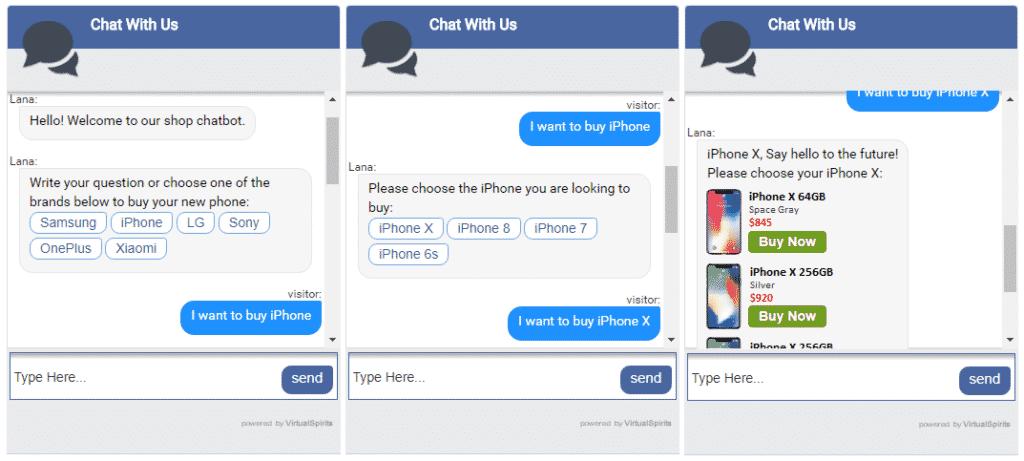
Image Source: VirtualSpirits.com
The firms having such chatbots usually mention it clearly to the users who interact with their support. The user then knows how to give the commands and extract the desired information. If a user asks something beyond the bot’s capability, it then forwards the query to a human support agent.
While these bots are quick and efficient, they cannot decipher queries in natural language. Therefore, they are unable to indulge in complex conversations with humans.
If you want a chatbot to quickly attend incoming user queries, and you have an idea of possible questions, you can build a chatbot this way by training the program accordingly. Such bots are suitable for e-commerce sites to attend sales and order inquiries, book customers’ orders, or to schedule flights.
2. Using Natural Language Processing (NLP)
Natural language processing (NLP) empowers the chatbots to conversate in a more human-like manner. At times, a user may not even detect a machine on the other side of the screen while talking to these chatbots.
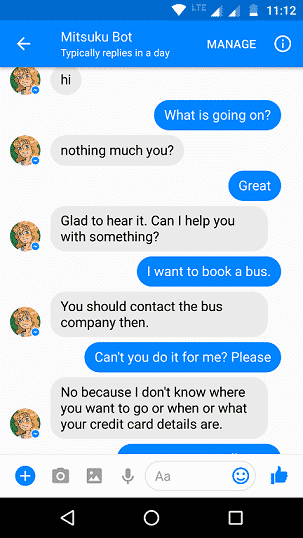
Source: Chatbots Magazine
NLP-based chatbots also work on keywords that they fetch from the predefined libraries. The quality of this communication thus depends on how well the libraries are constructed, and the software running the chatbot.
Moreover, these bots are jazzed-up with machine-learning to effectively understand users’ requests in the future.
Chatbot Architecture
To create a chatbot that delivers compelling results, it is important for businesses to know the workflow of these bots. From the receipt of users’ queries to the delivery of an answer, the information passes through numerous programs that help the chatbot decipher the input.
Precisely, most chatbots work on three different classification approaches which further build up their basic architecture.
1. Pattern Matches
Pattern matching is the process that a chatbot uses to classify the content of the query and generate an appropriate response. Most of these patterns are structured in Artificial Intelligence Markup Language (AIML). These patterns exist in the chatbot’s database for almost every possible query. Together, multiple patterns form a hierarchical structure.
Nonetheless, to fetch responses in the cases where queries are outside of the related patterns, algorithms assist the program by reducing the classifiers and creating a manageable structure.
2. Natural Language Understanding (NLU)
After a user enters a message, it reaches the NLU engine of the chatbot program for analysis and response generation. Precisely, NLU comprises of three different concepts according to which it analyzes the message.
Entity: An entity is the core idea of a chatbot that a firm decides. For instance, a chatbot for an online store may have payment systems or order tracking systems as entities.
Context: While scrutinizing the message, the NLU does not access the users’ text history. It means it analyzes the query independent of the previous conversation. Hence, to generate a proper response, the program stores the text from the users’ conversations as separate phrases flagged with distinct parameters, such as “Ordering Jacket”, or “Restaurant: KFC”. This helps the program to relate intents without the need to evaluate previous chat.
Intent: The other thing for which NLU analyzes the query is the Intent or the action from the chatbot in response to the message. For instance, the chatbot will give the same response to the user against the queries “Do you have blue fur jackets?”, “I want some nice blue fur jackets”, “Show me a good fur jacket in blue” since all of these messages trigger the same command for blue fur jackets.
3. Natural Language Processing (NLP)
Natural Language Processing (NLP) makes the chatbot understand input messages and generate an appropriate response. It converts the users’ text or speech data into structured data, which is then processed to fetch a suitable answer. This entire process consists of the following steps.
Tokenization: The program breaks the string of words into discrete fragments (tokens) that bear a linguistic representation with a unique value for the application.
Normalization: It analyzes the text for any possible misspells or typographical errors that could change the intended meaning of users’ queries.
Entity Recognition: The chatbot analyzes the text to identify the topic being talked about. It recognizes the entity by searching for a similar category of words, users’ data, or any other required information.
Dependency Parsing: The program scrutinizes the text for nouns, verbs, subjects, objects, and phrases to find any dependent information conveyed by the user.

Source: Stanford
Sentiment Analysis: The chatbot software assesses the users’ experiences by analyzing the text. It then forwards the query to a human if needed.
4. Knowledge Base
After deciding the intent, the chatbot interacts with the knowledge base to fetch information for the response.
The knowledge base serves as the main response center bearing all the information about the products, services, or the company. It has answers to all the FAQs, guides, and every possible information that a customer may be interested to know.
5. Data Storage

Another critical component of a chatbot architecture is database storage built on the platform during development. It holds all the chat logs and analytics.
Chatbot Architecture Diagram
Regardless of how simple or complex a chatbot architecture is, the usual workflow and structure of the program remain almost the same. It only gets more complicated after including additional components for a more natural communication.
Below is the basic chatbot architecture diagram that depicts how the program processes a request.
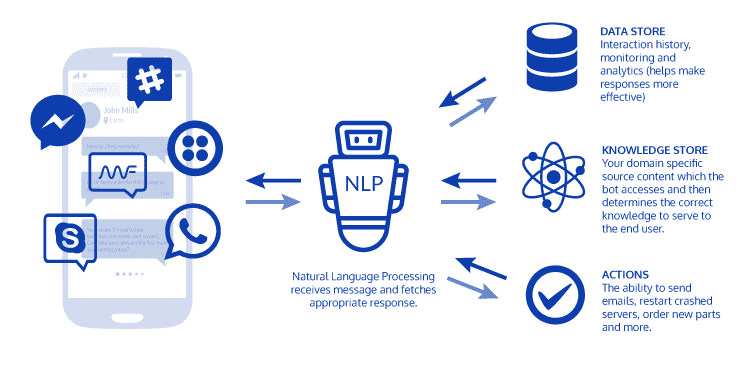
Source: Enterprise Bot Manager
Whereas, the following flowchart shows how the NLU Engine behind a chatbot analyzes a query and fetches an appropriate response.
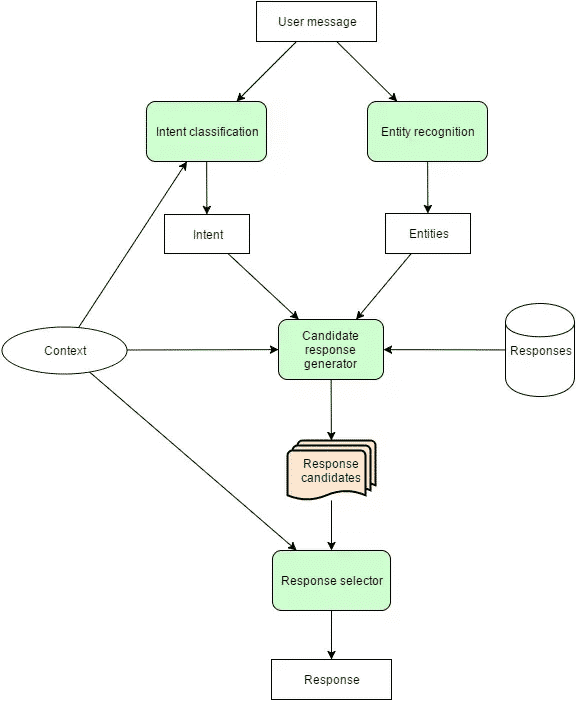
Source: Enterprise Bot Manager
How To Build A Chatbot From Scratch
Today, it is quite easy for businesses to create a chatbot and improve their customer support. One can either develop a chatbot from scratch by using background knowledge of coding languages. Or, thanks to the engineers that there now exist numerous tools online that facilitate chatbot development even by a non-technical user.
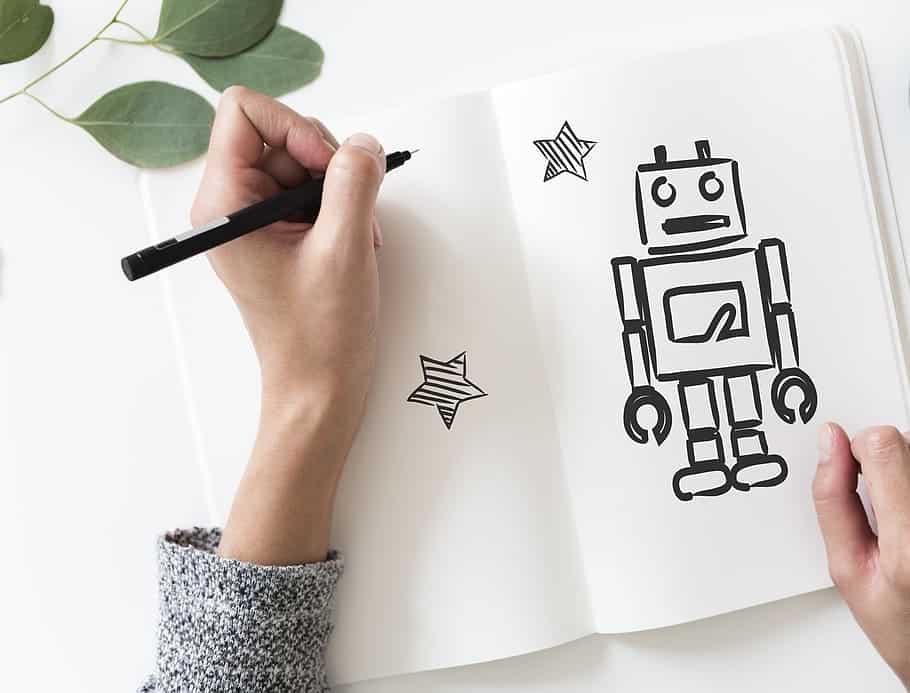
Nonetheless, the core steps to building a chatbot remain the same regardless of the technical method you choose. Let’s take a quick look at these steps.
1. Define Goals For Your Chatbot
The first step is to define the goals for your chatbot based on your business requirements and your customers’ demands. When you know what your chatbot should and would do, moving on to the other steps gets easy.
Nonetheless, make sure that your first chatbot should be easy to use for both the customers as well as your staff.
2. Decide A Communication Channel
Chatbots are flexible enough to integrate with various types of texting platforms. Depending upon your business needs, the ease of customers to reach you, and the provision of relevant API by your desired chatbot, you can choose a suitable communication channel.
For instance, you can build a chatbot for your company website or mobile app. Likewise, you can also integrate your chatbot with Facebook Messenger, Skype, any other messaging application, or even with SMS channels.
3. Design Conversational Language And Architecture
Considering your business requirements and the workload of customer support agents, you can design the conversation of the chatbot. A simple chatbot is just enough to provide immediate assistance to the customers. These bots usually follow FAQ-styled messages. Therefore, you need to develop a conversational style covering all possible questions your customers may ask.
Apart from writing simple messages, you should also create a storyboard and dialogue flow for the bot. This includes designing different variations of a message that impart a similar meaning. Doing so will help the bot create communicate in a smooth manner even when it has to say the same thing repeatedly.
Whereas, the more advanced chatbots supporting human-like talks need a more sophisticated conversational architecture. Such chatbots also implement machine learning technology to improve their conversations.
4. Choose Apps For Integration
As explained above, a chatbot architecture necessarily includes a knowledge base or a response center to fetch appropriate replies. For this purpose, you can either develop a dedicated knowledge base. Or, you can also integrate any existing apps or services that include all the information possibly required by your customers. Likewise, you can also integrate your present databases to the chatbot for future data storage purposes.
5. Data Collection
The sole purpose to create a chatbot is to ensure smooth communication without annoying your customers. For this, you must train the program to appropriately respond to every incoming query. Although, it is impossible to predict what question or request your customer will make. But, if you keep collecting all the conversations and integrate the stored chats with the bot, it will eventually help the program recognize the context of different incoming queries.
6. Select Development Platform
Today, numerous chatbot development tools are available that create smart chatbots in a short time. These tools employ NLP and allow creating chatbots according to the business requirements. These tools are desirable for every business since they require no coding from your end. Some of these chatbot maker tools include,
Whereas, if you are more interested in creating your own bot and you know how to code, you can use dedicated chatbot development frameworks. For example,
- Facebook Wit.AI
- IBM Watson
- Amazon Alexa Skill Kit
- Microsoft Bot Framework
- Google Dialogflow (former Api.ai)
Besides, if you want to have a customized chatbot, but you are unable to build one on your own, you can get them online. Services like Botlist, provide ready-made bots that seamlessly integrate with your respective platform in a few minutes. Though, with these services, you won’t get many options to customize your bot.
Also, you can hire online AI development solutions. Such firms provide customized services for building your chatbot according to your instructions and business needs. Whereas, with these services, you do not have to hire separate AI developers in your team.
7. Dialogue Flow Implementation
The final step of chatbot development is to implement the entire dialogue flow by creating classifiers. This will map a structure to let the chatbot program decipher an incoming query, analyze the context, fetch a response and generate a suitable reply according to the conversational architecture. Regardless of the development solution, the overall dialogue flow is responsible for a smooth chat with a user.
8. Testing And Deployment
The last phase of building a chatbot is its real-time testing and deployment. Though, both the processes go together since you can only test the chatbot in real-time as you deploy it for the real users. But that is very important for you to assess if the chatbot is capable enough to meet your customers’ needs. Monitor the entire conversations, collect data, create logs, analyze the data, and keep improving the bot for better conversations.
Things To Consider While Choosing Chatbot Platforms
Before investing in a development platform, make sure to evaluate its usefulness for your business considering the following points.
- User-friendly UI/UX
- Speed for building the bot
- NLP provision
- Support for languages
- Compatibility with front-end integrations, such as WhatsApp, Facebook Messenger, Slack.
- Back-end integrations such as CRM solutions, MongoDB or other databases, robotic platforms (like Blue Prism), and analytics platforms.
- Pricing plans (freemium, premium)
- Analytics and feedback provision
- Expandability
How Long Does It Take To Build A Chatbot
The total time for successful chatbot development and deployment varies according to the procedure.
For instance, the online solutions offering ready-made chatbots let you deploy a chatbot in less than an hour. With these services, you just have to choose the bot that is closest to your business niche, set up its conversation, and you are good to go.
Likewise, building a chatbot via self-service platforms such as Chatfuel takes a little long. Since these platforms allow you to customize your chatbot, it may take anywhere from a few hours to a few days to deploy your bot, depending upon the architectural complexity.
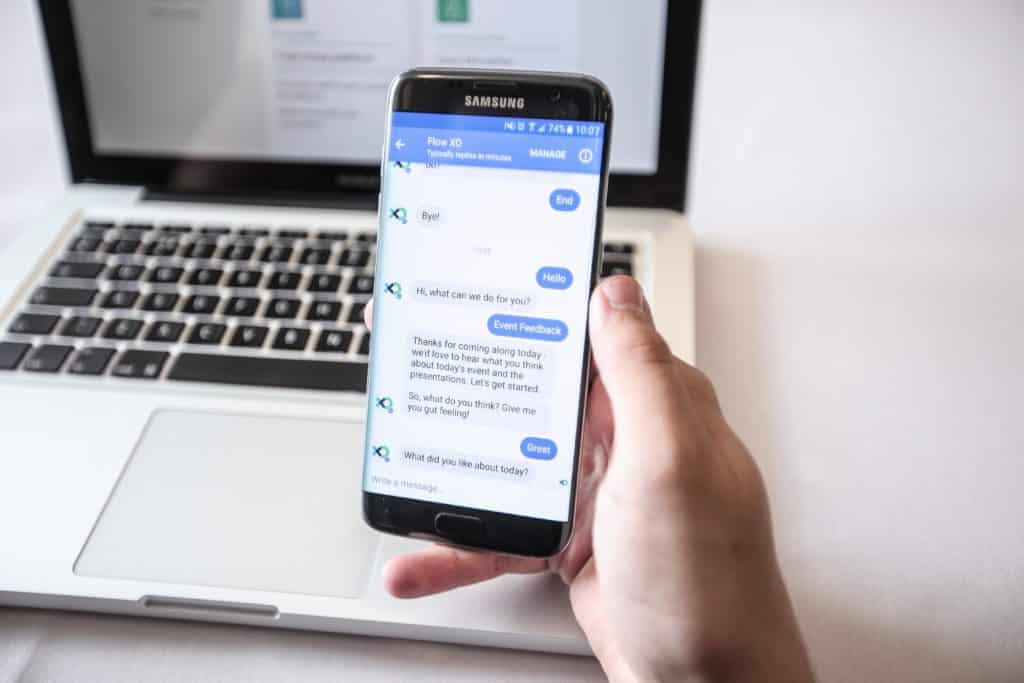
Whereas, if you choose to create a chatbot from scratch, then the total time gets even longer. Here’s the usual breakdown of the time spent on completing various development phases.
- Integration With Chat Platform: Based on the complexity, integrating the chatbot with a single chat platform may take 40-56 hours.
- Developing Conversational UI: Designing Command Language UI takes about 40-56 hours. Whereas, creating a chatbot with Natural Language UI may take around 120-160 hours.
- Adapting Business Logic: Integrating business logic, in case you already have API for your websites or mobile applications, takes about 120-160 hours. Whereas, if you build the business logic from scratch, the time may extend up to 192 hours.
On the other hand, building a chatbot by hiring a software development company also takes longer. Precisely, it may take around 4-6 weeks for the successful building and deployment of a customized chatbot.
Wrapping Up
Chatbots initially emerged as a luxury for organizations. Yet, they have now become a necessity for a thriving business. These bots help the firms in keeping their customers satisfied with continuous support. Moreover, they facilitate the staff by providing assistance in managing different tasks, thereby increasing their productivity.
Chatbots are equally beneficial for all large-scale, mid-level, and startup companies. All it takes for the firms to succeed with more sales, increased revenue, and growing customer base, is to build a chatbot that meets their requirements, is easy to maintain, and expandable according to their business needs. The more the firms invest in chatbots, the greater are the chances of their growth and popularity among the customers.